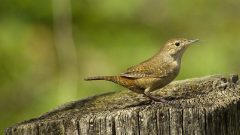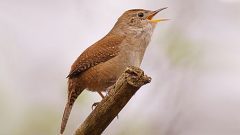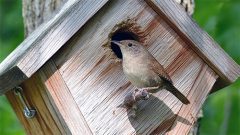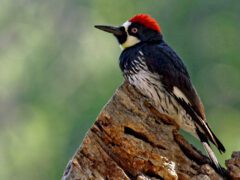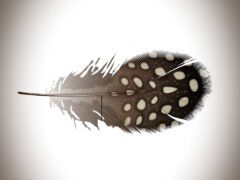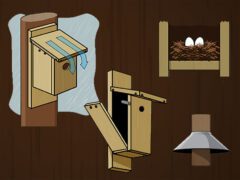Northern House Wren Similar Species Comparison
Main SpeciesNorthern House Wren
Adult (Northern)
Small, nondescript brown bird with a short tail, thin bill, and dark barring on wings and tail with a paler throat.
© Andy Witchger / Macaulay LibraryMinnesota, May 03, 2017Adult (Brown-throated)
The "Brown-throated" subspecies group, found in Southeastern Arizona and the mountains of Mexico, is warm brown, especially below.
© Ed Corey / Macaulay LibraryArizona, August 20, 2020Adult (Northern)
Small, fairly plain brown wren with indistinct eyebrow stripe and strongly barred tail and wings. Bubbly song is given frequently in spring and early summer.
© Daniel Jauvin / Macaulay LibraryQuebec, May 05, 2022Adult (Northern)
The distinctive loud bubbling song is often heard before the bird is seen.
© Blair Dudeck / Macaulay LibraryBritish Columbia, June 05, 2020Adult (Northern)
Dark barring on the wings and tail contrast with the more uniform brown plumage elsewhere.
© Evan Lipton / Macaulay LibraryMassachusetts, September 16, 2016Adult
Forages fairly low in tree branches and shrubs, eating mainly insects and spiders. This video has no audio.
© Larry Arbanas / Macaulay LibraryArizona, May 10, 2006Adult (Northern)
The "Northern" subspecies group breeds across southern Canada and most of the United States.
© Ceredig Roberts / Macaulay LibraryIdaho, June 07, 2019Adult (Northern)
Nests in nest boxes, old woodpecker nests, natural crevices, and other cavities.
© Larry Van Brunt / Macaulay LibraryNew York, May 08, 2019Adult (Northern)
Song is a long, bubbly jumble of trills and scolds given by both males and females. Often pushes tail downward while singing, unlike other wrens.
© Timothy Barksdale / Macaulay LibraryNew York, May 30, 2004Habitat (Northern)
Found in scrubby habitats, often close to homes and buildings.
© Court Harding / Macaulay LibraryFlorida, October 26, 2019Adult (Northern)
Nests in tree cavities and birdhouses, where it is a strong competitor for nest sites and may evict larger birds to claim the spot for its own.
© Jay McGowan / Macaulay LibraryMontana, June 26, 2015Similar SpeciesWinter Wren
Adult/immature
Winter Wrens are smaller and more plump with a shorter tail and a shorter bill than Northern House Wrens. They are not frequently seen in the open or around houses like NorthernHouse Wrens.
© Davey Walters / Macaulay LibraryMassachusetts, December 04, 2016Similar SpeciesPacific Wren
Adult/immature
Pacific Wrens are smaller and rounder than Northern House Wrens with a shorter tail and bill. They tend to stay in thick vegetation and aren't frequently found in the open or around houses like NorthernHouse Wrens.
© Cameron Eckert / Macaulay LibraryAlaska, October 23, 2016Similar SpeciesBewick's Wren
Adult/immature
Bewick's Wrens are larger than Northern House Wrens with an obvious white eyebrow that NorthernHouse Wrens lack.
© DigiBirdTrek CA / Macaulay LibraryCalifornia, January 30, 2016Similar SpeciesCarolina Wren
Adult
Carolina Wrens are larger than Northern House Wrens with an bright white eyebrow unlike the plain brownish face of the NorthernHouse Wren.
© Evan Lipton / Macaulay LibraryMassachusetts, December 08, 2014Similar SpeciesMarsh Wren
Adult/immature
Marsh Wrens occur in wetlands where most Northern House Wrens don't venture. They have paler underparts than NorthernHouse Wrens with a more distinctive eyebrow.
© Tony V / Macaulay LibraryWashington, May 15, 2017Similar SpeciesSedge Wren
Adult/immature
Sedge Wrens occur in wet tall-grass meadows where Northern House Wrens rarely venture. They have a more distinct pale eyebrow and more streaking on the back than NorthernHouse Wrens.
© Andrew Burnett / Macaulay LibraryKansas, November 30, 2013Similar SpeciesRock Wren
Adult
Rock Wrens are larger than Northern House Wrens with a longer tail and bill. They are also much paler all around than the rich brown NorthernHouse Wren.
© Brian Sullivan / Macaulay LibraryCalifornia, May 30, 2016Compare with Similar Species
Click on an image to compare
Species in This Family
Wrens(Order: Passeriformes, Family: Troglodytidae)
More to Read
Don't miss a thing! Join our email list
The Cornell Lab will send you updates about birds,
birding, and opportunities to help bird conservation.













